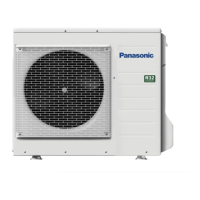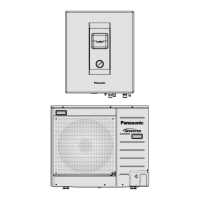What causes the water flowing sound in my Panasonic WH-UD28AE Heat Pump?
- RRachael MyersAug 27, 2025
The water flowing sound you hear during the operation of your Panasonic Heat Pump is due to the refrigerant flow inside the unit.

What causes the water flowing sound in my Panasonic WH-UD28AE Heat Pump?
The water flowing sound you hear during the operation of your Panasonic Heat Pump is due to the refrigerant flow inside the unit.
Why can't my Panasonic Heat Pump get warm instantly?
If your Panasonic Heat Pump system cannot get warm instantly, it may be because heatpump systems need some time to heat up the water if the unit is operated from a cold start.
Why is my Panasonic Heat Pump system difficult to heat up?
If your Panasonic Heat Pump system is difficult to heat up, consider the following potential causes: * When heating is operated by the indoor unit together with floor heating or a panel heater simultaneously, the warm water temperature may decrease, weakening the heat-up of the floor heating or panel heater. * Low outdoor air temperature can make it difficult to get warm. * Snow pile blocking the discharge outlet or intake inlet of the outdoor unit. * Low water outlet set temperature.
Why is the operation LED not lit on my Panasonic WH-UD28AE?
If the operation LED is not lit or the control panel display is blank on your Panasonic Heat Pump, it may be due to a power supply issue or a power failure.
Safety precautions for the indoor unit, including installation and repair warnings.
Safety guidelines for power supply, including cord usage and wet hands.
Safety precautions for the outdoor unit, warning against inserting fingers or objects.
Safety measures for the control panel, advising against water and pointed objects.
Guidelines for proper disposal of electrical and electronic equipment and packaging.
Details of the indoor unit, including the water pressure gauge and its safety.
Overview of the control panel, its buttons, indicators, and displays.
Instructions for basic operation, starting, stopping, and default settings.
Details on optional settings like error code reset and system pump down.
Guide to advanced settings for temperature ranges and parameters.
Instructions for cleaning the indoor unit and control panel with a soft cloth.
Guidelines for maintaining the outdoor unit, vents, and clearing snow.
Procedures for seasonal inspections and preparing for extended non-use.
Common sounds and operational delays that are not signs of malfunction.
Common checks for inefficient operation, noise, or unit failure.
Procedure for handling error codes displayed on the control panel.
How to enter and use status mode to check compressor frequency or error history.
Conditions requiring consultation with an authorized dealer for service.












